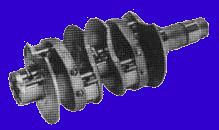
Crankshafts and Flywheels

If you plan on using your engine at over 5500 rpm, which is
quite likely and the best way to give you more speed and power, you can forget
using your stock crank. There are, like most other parts, loads of different
crankshafts on the market, the bottom of the range is a welded counterweight
69mm crank. The counterweights are what allow you to exceed 5500 rpm. All cranks
this guy will mention from this point will have counterweight on them, either
welded or forged from new.
In case the words "counterweights" are just words to you, here's what they do.
The big end, the bit the con rod bolts to, is offset and so will pull the crank
in an uneven circle, in fact it will put pressure on the bearings. Imagine a
fairground ferris wheel with only a quarter of the people on board and all
together, once the speed increases the strain on the frame holding the wheel up
would be immense, so the speed would need to be kept down. If you now fully
loaded the wheel, the speed could be increased, as despite the extra weight, it
was distributed evenly. The same effect happens with the crankshaft, so by
fitting a counterweight, the extra people, the crank can rotate faster. A faster
rotating crank, a faster moving car.
After
the welded counterweights comes forged cranks, these come in many different
sizes from 69mm up. There are two crankshafts this guy would recommend, firstly
a 69mm, either welded or forged, and a 78mm forged. These two will give you
reliable horsepower from a 1585cc up to a 2007cc from a standard case.
Crankshafts over 69mm are referred to as 'strokers'.
The advantage of using a 69mm crank is that it can rotate faster than a stroker
(a smaller circle and therefore less distance to travel to complete the circle).
Remember an engine is an air pump, the faster and easier you can get the air in
and out, the faster the engine will go. So with that in mind, you can see how a
short stroke, although giving a smaller capacity and theoretically a lower power
output can run faster and give a higher rpm. For street use this isn't always a
great advantage as it requires the revs to be quite high to get full benefit,
but if you intend taking your animal to the strip it could work well. Of course
this then requires a lot more head work and getting the exact camshaft for your
needs.
All 'aftermarket' (that this guy is aware of) cranks come drilled for 8 dowel
pins, these are the bits that keep the flywheel turning with the crank. The more
pins the more chance of the flywheel staying attached to the crank. The nut that
holds these two together needs, as standard, 250 lbs/ft (35mkg) which is quite
an amount of pressure. To give you some idea of what that means, if you hang 18
inches (45cms) down a bar with a socket on the end you would need to weigh
165lbs/75kgs (12 stone) to get it to torque. For a high powered engine this guy
would recommend about 400- 500 lbs/ft (55-70mkg), this means if you do weigh 165
lbs you will now need to be between 2.5 and 3 feet (75-90cms) down the bar. All
that weight on a 36mm headed bolt, wow.
The journals (the bits the bearings go on) are available in many different sizes
to fit different con-rods, so you need the matching size con-rods (see that
section), but why cause more expense than is really necessary?
There are also flanged crankshafts, these have a larger flywheel end which
allows for better mating with the flywheel, but does need a special bearing set
and a matching flywheel. More expense.
Whilst on the subject of flywheel mating, there are wedge-mated crank and
flywheel sets available. These have been machined with a taper on both the crank
end and the matching flywheel face, this does work well, but remember, you might
be the one who will have to separate them one day. They work just like steering
rod ball joints, have you ever tried to get one of those off? But, once again,
if you intend to stay below 200BHP you will never need one of these.
There are heavy duty nuts and larger washers available, they are usually made of
chrome-moly steel. They aren't generally needed as the standard nuts will take
at least 400lbs/ft (55mkg) and who needs a larger washer (they are meant to keep
the dowels in place), where are the dowel pins expected to go? Having said all
that, they aren't expensive.
Your flywheel, apart from requiring the extra 4 dowel holes should be machined
to weigh between 10 and 13 lbs (4.5-6 kgs), the weight must be removed from the
outer most edge (not the teeth) and most machine shops will be able to carry out
this operation for you. You could always buy a ready cut flywheel, but of course
you will have to pay for a flywheel that you already have and then you'll have
one spare when you've finished.
Once you have your flywheel and crank ready, fit the #3 bearing and the two
drive gears, get your clutch pressure plate and take them to a balancer, it is
well worth it as it allows for a smoother running engine along with the fact it
will should help your engine last longer.
Whilst we areon the subject of longevity, it should be noted that if you
increase your power output you can expect parts to wear out a little more
quickly, and so doing everything you can to make the engine run smoother will
slow this degradation. I will point out anything to help this as we go.
One last point, there are shims in between the crankshaft and the flywheel,
these set the crankshaft endfloat. The recommended gap is 0.07-0.13mm
(0.003-0.005in), open that up to about 0.25mm (0.010in) if your engine is going
to be over 120BHP. This will allow the extra heat to be dissipated better from
the crank and crankcase without binding (NB the case and crank expand and
contract at different speeds).
To help you decide the length of stroke you require, use this calculation,
Bore X Bore X Stroke X 0.0031416.
|

![]()


